 文獻來源: Owens GL, Windsor DJ, Mui J, Taylor JS. 2009. A Fish Eye Out of Water: Ten Visual Opsins in the Four-Eyed Fish, Anableps anableps. PLoS One 4(6): e5970. doi:10.1371/journal.pone.0005970
文獻來源: Owens GL, Windsor DJ, Mui J, Taylor JS. 2009. A Fish Eye Out of Water: Ten Visual Opsins in the Four-Eyed Fish, Anableps anableps. PLoS One 4(6): e5970. doi:10.1371/journal.pone.0005970Abstract
The “four-eyed” fish Anableps anableps has numerous morphological adaptations that enable above and below-water vision. Here, as the first step in our efforts to identify molecular adaptations for aerial and aquatic vision in this species, we describe the A. anableps visual opsin repertoire. We used PCR, cloning, and sequencing to survey cDNA using unique primers designed to amplify eight sequences from five visual opsin gene subfamilies, SWS1, SWS2, RH1, RH2, and LWS. We also used Southern blotting to count opsin loci in genomic DNA digested with EcoR1 and BamH1. Phylogenetic analyses confirmed the identity of all opsin sequences and allowed us to map gene duplication and divergence events onto a tree of teleost fish. Each of the gene-specific primer sets produced an amplicon from cDNA, indicating that A. anableps possessed and expressed at least eight opsin genes. A second PCR-based survey of genomic and cDNA uncovered two additional LWS genes. Thus, A. anableps has at least ten visual opsins and all but one were expressed in the eyes of the single adult surveyed. Among these ten visual opsins, two have key site haplotypes not found in other fish. Of particular interest is the A. anableps-specific opsin in the LWS subfamily, S180γ, with a SHYAA five key site haplotype. Although A. anableps has a visual opsin gene repertoire similar to that found in other fishes in the suborder Cyprinodontoidei, the LWS opsin subfamily has two loci not found in close relatives, including one with a key site haplotype not found in any other fish species. A. anableps opsin sequence data will be used to design in situ probes allowing us to test the hypothesis that opsin gene expression differs in the distinct ventral and dorsal retinas found in this species.
圖片連結: ryanphotographic.com (photo credit: Paddy)

















































